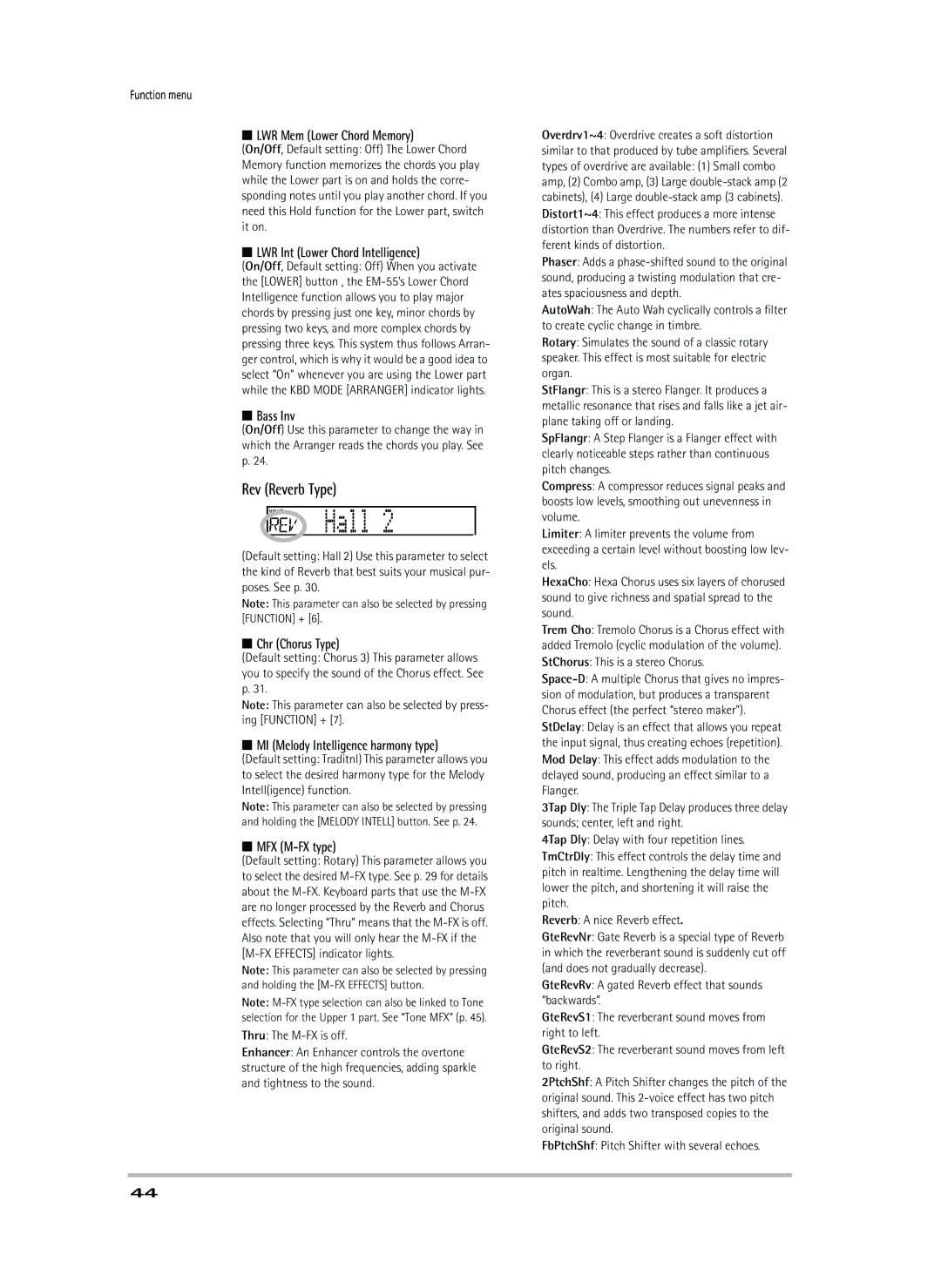
Function menu
■LWR Mem (Lower Chord Memory)
(On/Off, Default setting: Off) The Lower Chord Memory function memorizes the chords you play while the Lower part is on and holds the corre- sponding notes until you play another chord. If you need this Hold function for the Lower part, switch it on.
■LWR Int (Lower Chord Intelligence)
(On/Off, Default setting: Off) When you activate the [LOWER] button , the
■Bass Inv
(On/Off) Use this parameter to change the way in which the Arranger reads the chords you play. See p. 24.
Rev (Reverb Type)
VALUE




 Hall 2
Hall 2
(Default setting: Hall 2) Use this parameter to select the kind of Reverb that best suits your musical pur- poses. See p. 30.
Note: This parameter can also be selected by pressing [FUNCTION] + [6].
■Chr (Chorus Type)
(Default setting: Chorus 3) This parameter allows you to specify the sound of the Chorus effect. See p. 31.
Note: This parameter can also be selected by press- ing [FUNCTION] + [7].
■MI (Melody Intelligence harmony type)
(Default setting: Traditnl) This parameter allows you to select the desired harmony type for the Melody Intell(igence) function.
Note: This parameter can also be selected by pressing and holding the [MELODY INTELL] button. See p. 24.
■MFX (M-FX type)
(Default setting: Rotary) This parameter allows you to select the desired
Note: This parameter can also be selected by pressing and holding the
Note:
Thru: The M-FX is off.
Enhancer: An Enhancer controls the overtone structure of the high frequencies, adding sparkle and tightness to the sound.
Overdrv1~4: Overdrive creates a soft distortion similar to that produced by tube amplifiers. Several types of overdrive are available: (1) Small combo amp, (2) Combo amp, (3) Large
Phaser: Adds a
AutoWah: The Auto Wah cyclically controls a filter to create cyclic change in timbre.
Rotary: Simulates the sound of a classic rotary speaker. This effect is most suitable for electric organ.
StFlangr: This is a stereo Flanger. It produces a metallic resonance that rises and falls like a jet air- plane taking off or landing.
SpFlangr: A Step Flanger is a Flanger effect with clearly noticeable steps rather than continuous pitch changes.
Compress: A compressor reduces signal peaks and boosts low levels, smoothing out unevenness in volume.
Limiter: A limiter prevents the volume from exceeding a certain level without boosting low lev- els.
HexaCho: Hexa Chorus uses six layers of chorused sound to give richness and spatial spread to the sound.
Trem Cho: Tremolo Chorus is a Chorus effect with added Tremolo (cyclic modulation of the volume). StChorus: This is a stereo Chorus.
3Tap Dly: The Triple Tap Delay produces three delay sounds; center, left and right.
4Tap Dly: Delay with four repetition lines.
TmCtrDly: This effect controls the delay time and pitch in realtime. Lengthening the delay time will lower the pitch, and shortening it will raise the pitch.
Reverb: A nice Reverb effect.
GteRevNr: Gate Reverb is a special type of Reverb in which the reverberant sound is suddenly cut off (and does not gradually decrease).
GteRevRv: A gated Reverb effect that sounds “backwards”.
GteRevS1: The reverberant sound moves from right to left.
GteRevS2: The reverberant sound moves from left to right.
2PtchShf: A Pitch Shifter changes the pitch of the original sound. This
FbPtchShf: Pitch Shifter with several echoes.
44
